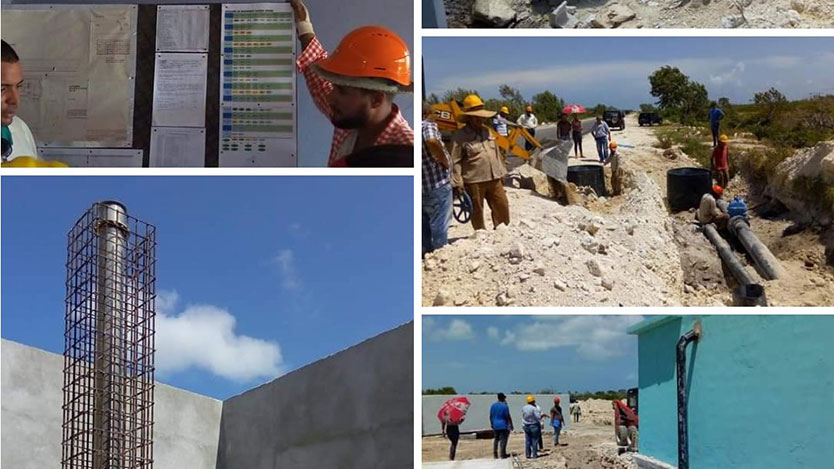At the end of 2022, the delivery of hydraulic works with use value for the supply and sanitation to the population, the solution to historical approaches and the execution of works associated with the hotel development in the Jardines del Rey destination were left in Ciego de Ávila, all of them at through investment processes.

The limitations of electricity and fuels during the period prevented a greater physical progress of the investments, nevertheless several works with use value were delivered for the supply of water and the evacuation of residuals to the population.
Edwin González González, delegate of the National Institute of Hydraulic Resources in Ciego de Ávila, told Invasor that actions related to COVID-19 were also carried out and the solution to claims from vulnerable communities such as those in El Cartón neighborhood, in Ceballos, which benefited to 945 inhabitants.
He added that, during the past year, work continued on the aqueduct of the town of Florencia, although without the delivery of objects with use value.
One factor that prevented further advances, the delegate comments, was the rising prices of fundamental raw materials in the international market such as high-density polyethylene (HDPE).
“When we began to build the Turiguanó-La Bandera pipeline, heading to the northern keys, the kilometer (km) of 800-millimeter (mm) pipe cost around one million pesos. At the beginning of December, that same distance already amounted to 11 million pesos.
Work continued on the supply and sanitation networks in the investment of houses built through the Punta Alegre Sandino system, in addition to the waste collector of the 5,000 houses in the city of Morón, but not at the desired rate. This work will benefit neighboring areas such as the La Victoria, Villamil and Peñaranda districts in the future.
Likewise, in the city of Morón, the movement of earth for the construction of an elevated tank of 12,000 cubic meters (m3) was completed, the largest that the province will have, its construction paralyzed due to the affectation of cement and fuel, González González said.
This work will be essential to create the Morón Hourly Distribution Center, located on an esplanade behind the Roberto Rodríguez General Teaching Provincial Hospital, which with pumping stations at kilometer 35 of the highway to Ciego de Ávila and another future one named La Teresa ( in the direction of the Patria Popular Council), will sectorize the service to the 5000 homes and will inject more water into the city.
More than 16,500 citizens from Ciego de Ávila were benefited last year by the supply networks, a figure above what was initially estimated. This was not the case with the sanitation, due to delays in the execution of the waste collector for the work on the 5,000 homes in Rooster City, the non-completion of its fourth stage due to delays in the housing construction schedule and the failure to arrival of imported parts necessary to give it use value, which caused them to fall well below what was planned.
The hotel growth in the Jardines del Rey tourist destination played an important part in the hydraulic investment plan, among them the aforementioned Turiguanó-La Bandera conductor (12.5 km in total) stands out, to give it use value as soon as the conditions allow it.
Ready for use, the supply conductor was delivered to the Cayo Coco Popular Camping facility, as well as the three sections of sectorization networks called Cayo Guillermo polynets (including water supply, residuals and fertigation), which at the time, given the Concentrations of minerals in our groundwater presented a high degree of incrustation, said the INRH provincial delegate.
Similarly, the polynets were delivered in Cayo Romano, which serve the hotels built in Cayo Paredón, a project that meets the ecological requirements of the area.
There were several waste treatment plants (PTR) in which it operated during the period in the northern keys of Ciego de Avila, with a greater or lesser level of complexity. An example of this were the works carried out in those of Palma Real-Las Coloradas, that of Cayo Guillermo and Cayo Romano.
For its part, little or almost nothing could be done at the Cayo Coco desalination plant due to the lack of large volumes of concrete required by the work, González González added.
In the final months of the year, the works of the Zaza-Ciego magistral canal began to be used more strongly for agricultural irrigation, although still well below its potential. The initial steps were taken in the municipality of Majagua, where more than 900 hectares (ha) can be irrigated. To this end, channels are built on land (secondary) to carry the water initially by gravity, until other more efficient systems are planned in the future.
Currently, the Zaza-Ciego canal only has use value in regulator 5, planted with cyprinids of the Hydraulic Resources Services Base Business Unit, in addition to the lands of the Ramón Domínguez de la Peña Agricultural Production Cooperative, in the municipality of Venezuela, and four ha of La Teresa fingerling center (which can reach 18).




